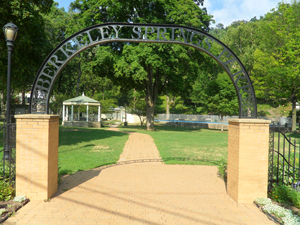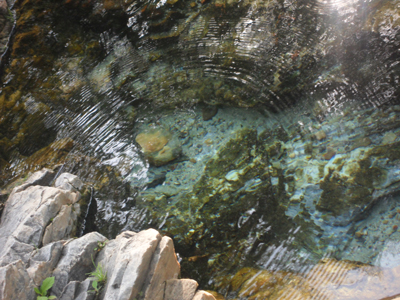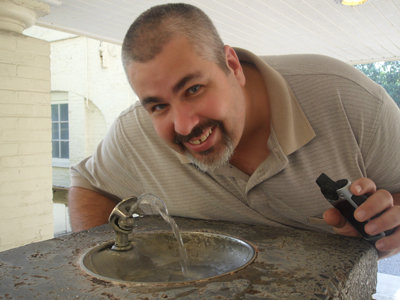
Welcome to Berkeley Springs.
The sign where this cache is located has been taken down for a while, so I have updated the question I'd like you to answer. As soon as the sign is replaced I'll update the cache.
What is a spring, how does a mineral spring pick up its minerals, and why is the water warm?
Also let’s learn the classifications of springs, and how to determine their classifications.
We will also take a few moments to discuss the history of Berkeley Springs, and how a spring created a town.
Here is the definition of a spring from Wikipedia:
A spring is a component of the hydrosphere, namely any natural occurrence where water flows to the surface of the earth from below the surface. Thus it is where the aquifer surface meets the ground surface.
Now the first thing you may ask yourself is; what the heck is a hydrosphere?
Simply the hydrosphere is all the earth’s water.
Next what is an aquifer, it is an underground layer of permeable rock (rock that water can freely flow through), sediment (gravel or sand) or soil that will absorb water. The spaces in the aquifer are all interconnected letting the water flow. Sandstone, loose gravel and porous limestone make the best aquifers.
We know what the hydrosphere is, and an aquifer is simply rock, sand or gravel, or soil that lets the water flow through it underground, and a spring is simply where that water comes out of the ground.
Now that you understand how a spring works, lets discuss how a spring is classified. Springs are classified by how much water flows to the surface. This is known as the springs magnitude.

Here is a chart for spring magnitude.
You will need this for your answers.
A 1st Magnitude spring flows more than 2800 Liters per Second
A 2nd Magnitude spring flows between 280 to 2800 Liters per Second
A 3rd Magnitude spring flows between 28 to 280 Liters per Second
A 4th Magnitude spring flows between 6.3 to 28 Liters per Second
A 5th Magnitude spring flows between 0.63 to 6.3 Milliliters per second
A 6th Magnitude spring flows between 63 to 630 Milliliters per second
A 7th Magnitude spring flows between 8 to 63 Milliliters per second
A 8th Magnitude spring flows between 8 Milliliters per second
A Zero Magnitude spring has no flow anymore, but once flowed.
At Berkeley Springs the water flows through the Oriskany sandstone of Warm Springs Ridge and out along its base it is known as a warm water spring because the water is warmer than normal ground water. It is not known how the water picks up this heat, but it flows at a constant temperature.
Lastly as the water of Berkeley Springs passes through the ground it erodes the sandstone, picking up minerals that were said to have healing powers.
To receive credit for this Earthcache you will need to do the following.
First you will need to e-mail me the answers to the following questions.
At the posted coordinates you will find an informational marker describing Berkeley Spring.
On that marker you will find how many gallons per minute the spring flows and some of the minerals found in the water.
Question 1: What is the flow rate of the spring in Gallons per Minute?
Question 2: Use the above formula and chart, and give me the Classification of the spring.
Question 3: What are the minerals that are in the water?
Question 4: What is the temperature of the water?
Until the sign that has the information put back up please answer the following question.
How many paces is it from George Washington's bath tub to the museum?

I hope you enjoy your stop at Berkeley Springs Earthcache, while you are here you may find it interesting that the spring is actually the reason for the town.
Before Columbus discovered America, the Indians traveled from as far away as Canada to the Carolinas to the warm mineral springs of the area. They believed the waters had healing powers.
In 1748 young George Washington was on a team to survey land owned by Lord Fairfax. While on the surveying trip Washington fell in love with the area, and returned several times.
In a letter to Reverend Charles Green in 1761 he wrote, “I think myself benefitted from the water and not without hope of their making a cure for me. A little time will show now.”
In 1776 he and some close friends established the town of Bath for the purpose of being able to entertain the Virginia’s social elite who traveled to the springs to bathe in its warm mineral waters.
Bath’s popularity increased as wounded soldiers came looking for the healing powers of the springs.
Although the town is still officially known as Bath it has been called Berkeley Springs since the post office opened, and since there was already a Bath West Virginia a unique name had to be taken.
You can visit Berkeley Springs State Park, where you can still see George Washington’s bath, as well as the spa, and the spring. There are also drinking fountains and stations where you can fill up water jugs to take with you.

Or you can have a refreshing drink from the fountain.
Congratulations goes out to LisaandDarin for being first to find, and braving the snow to do it!